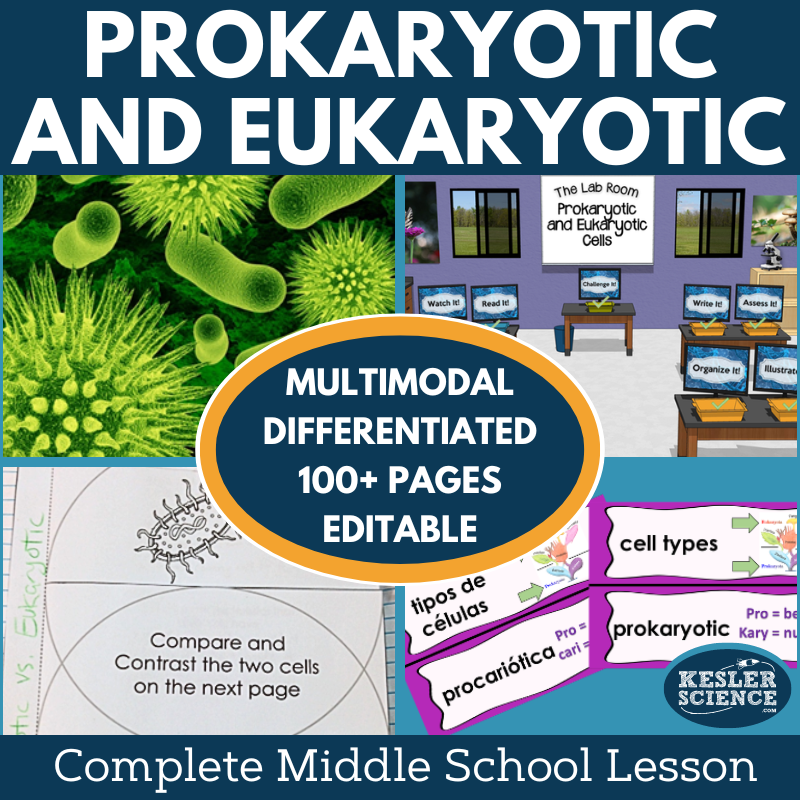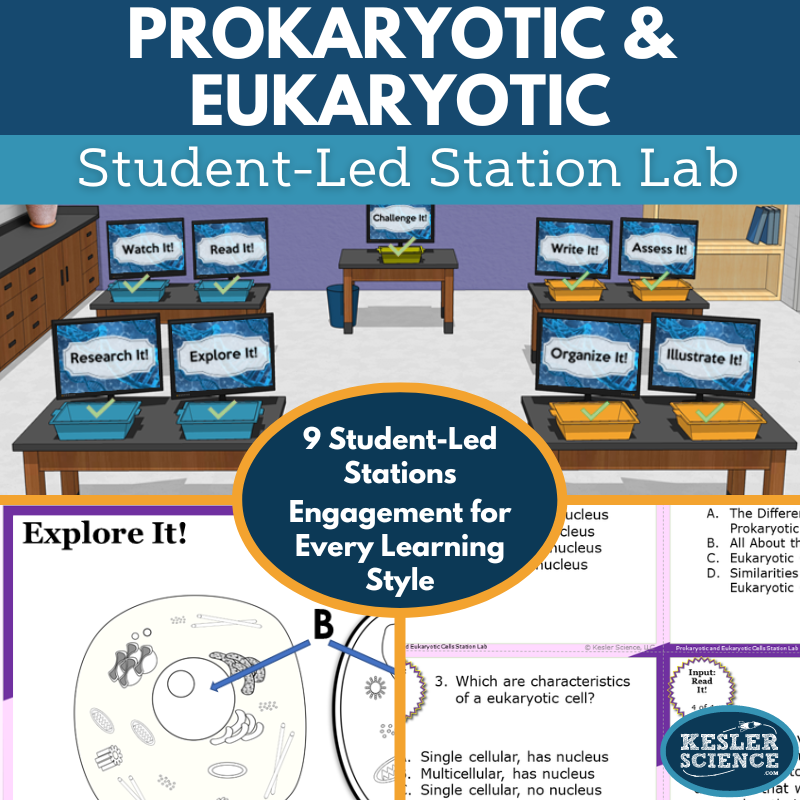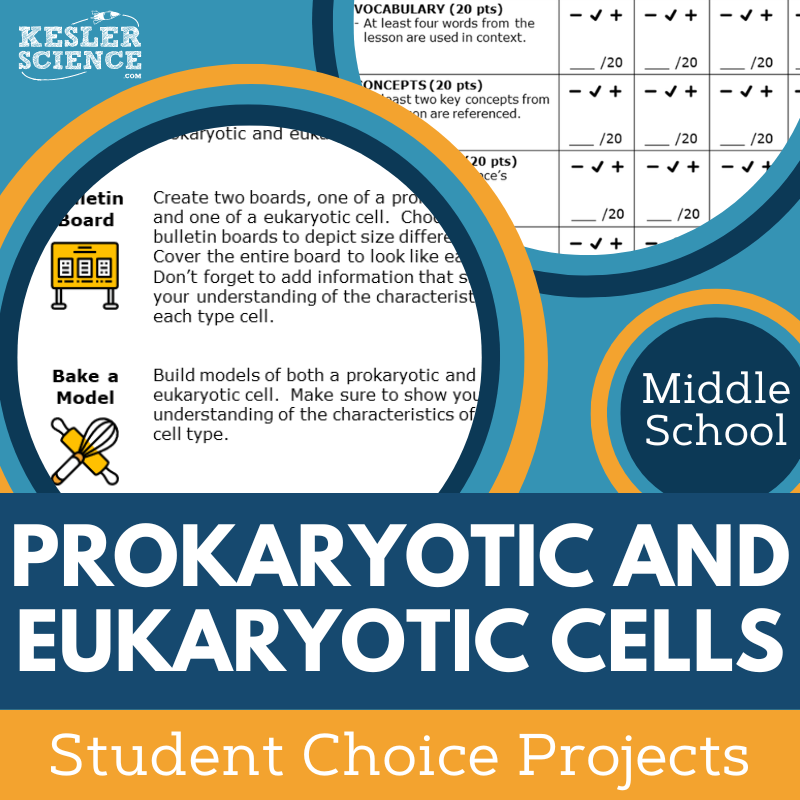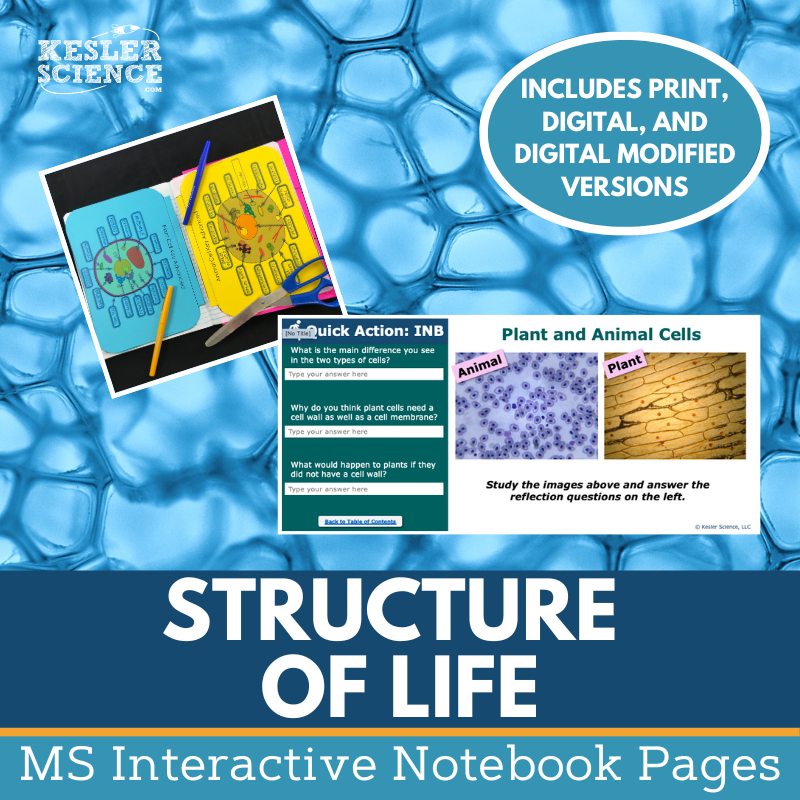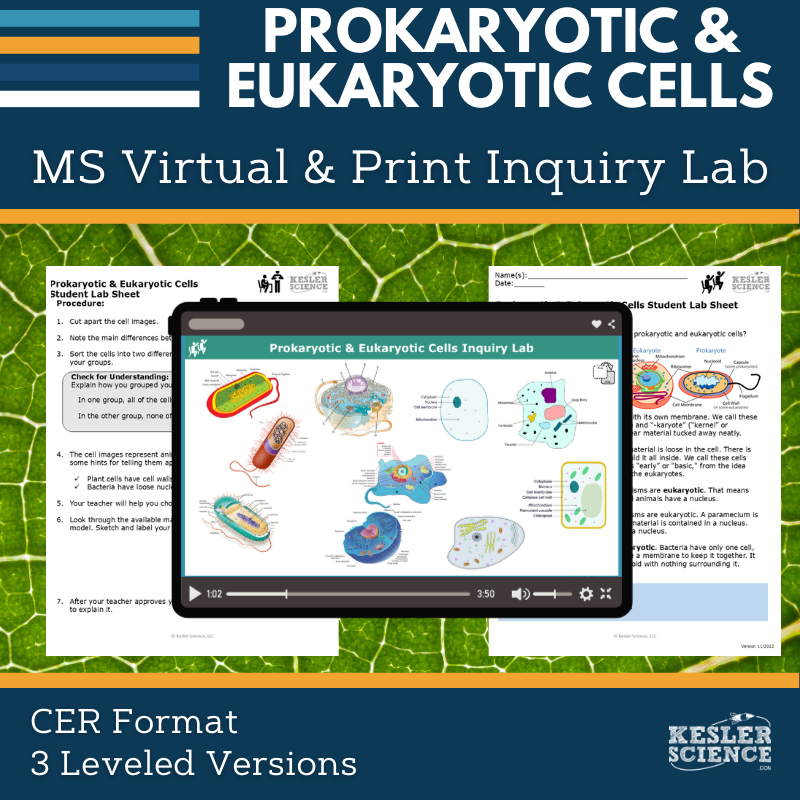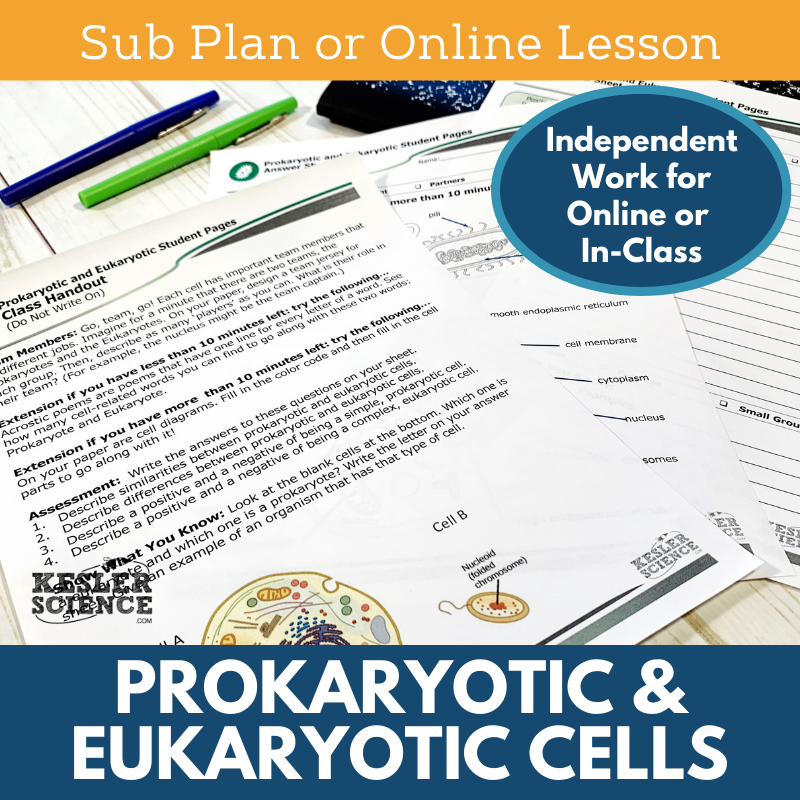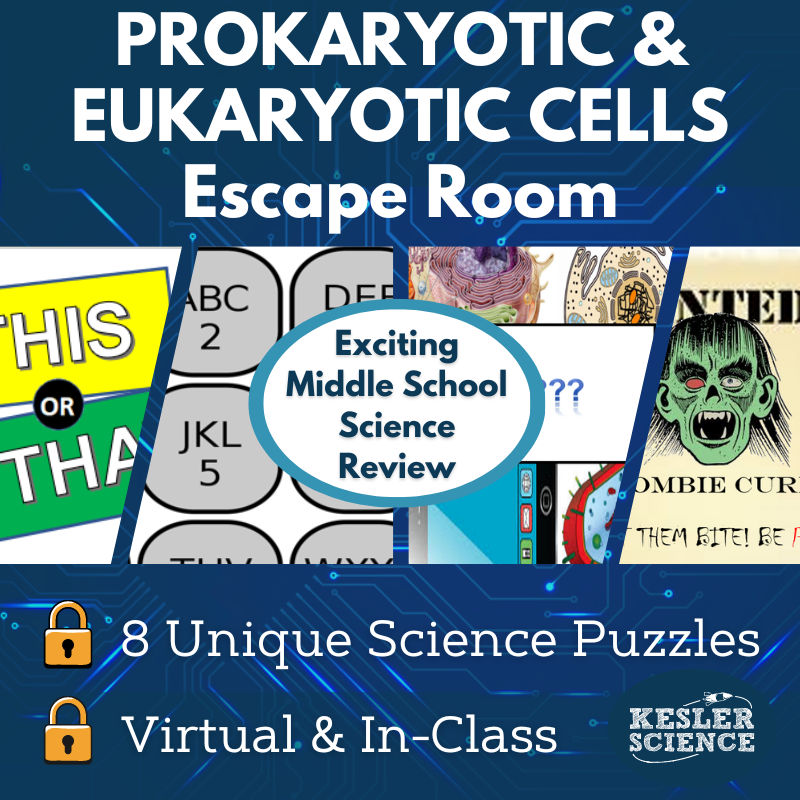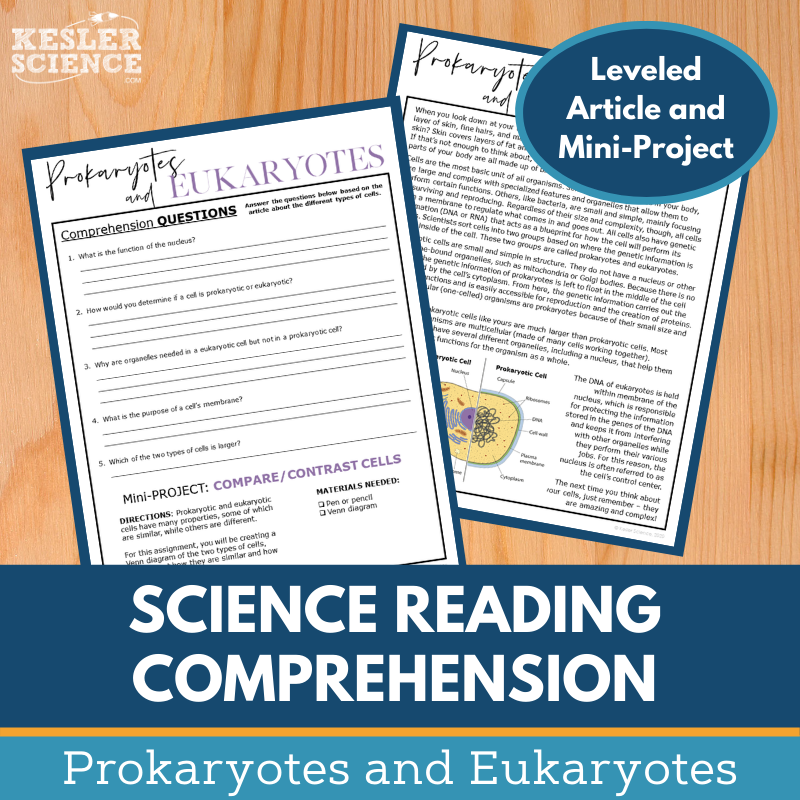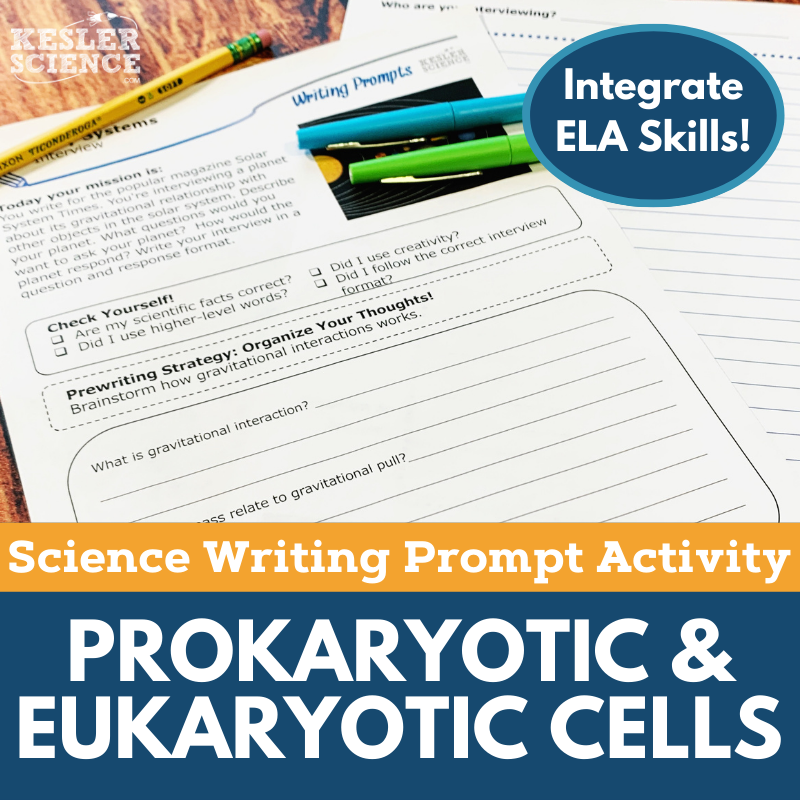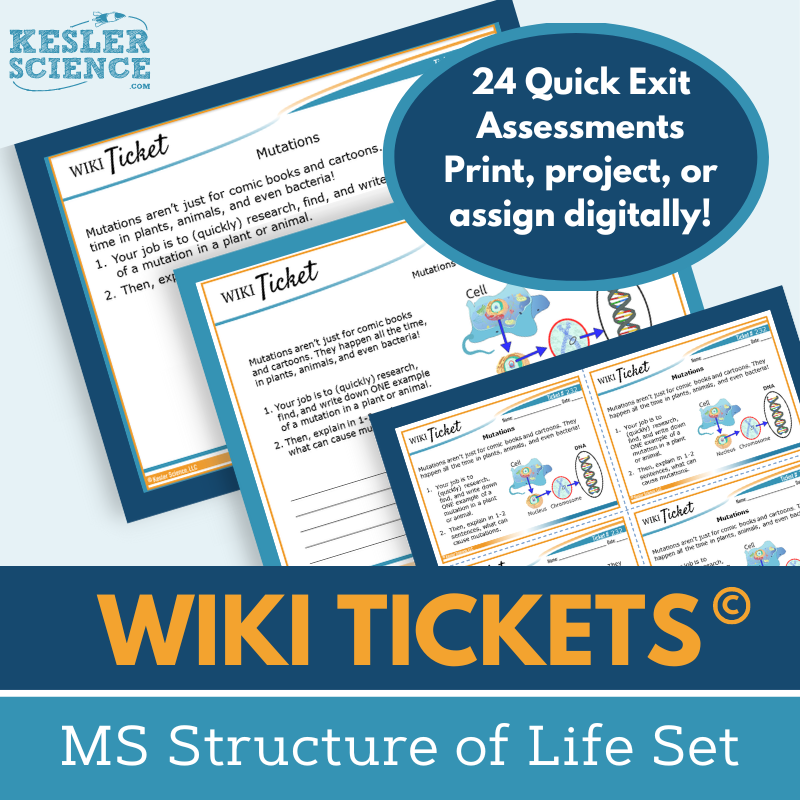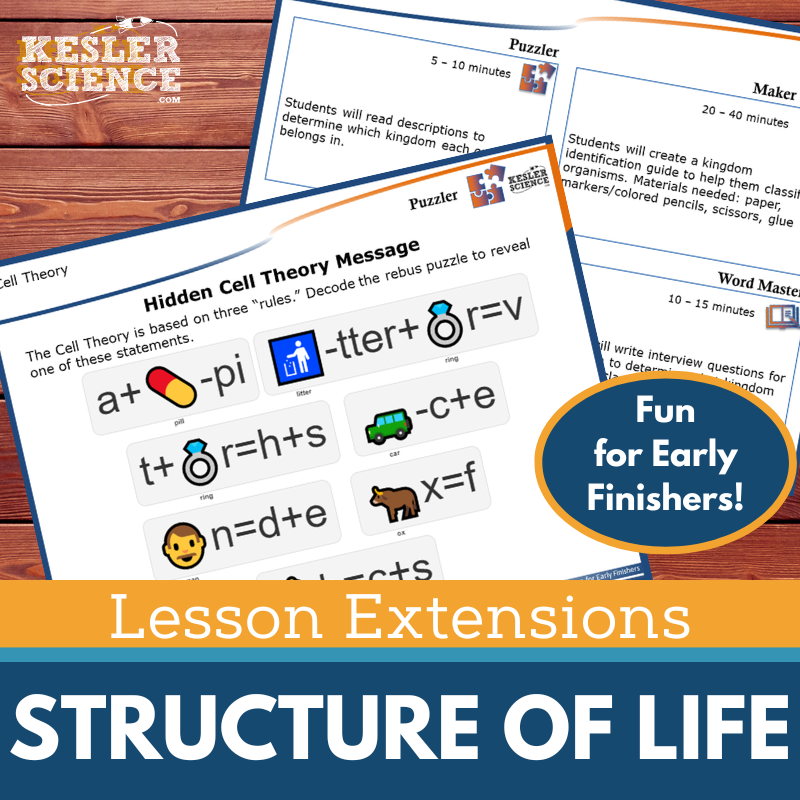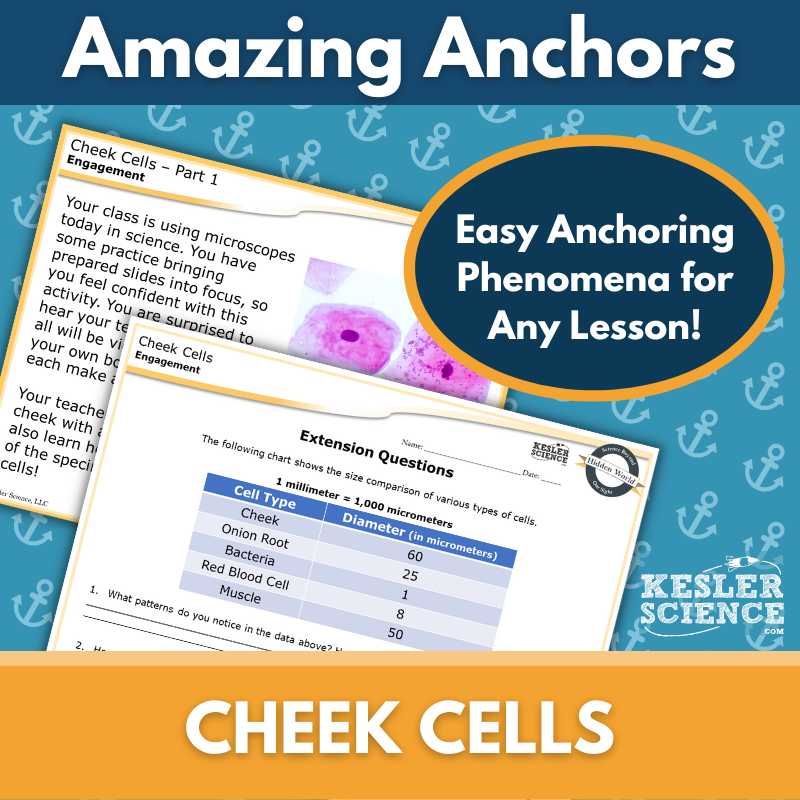Prokaryotic and Eukaryotic Cells Activities for Middle School Science
The Kesler Science Prokaryotic and Eukaryotic Cells resources provide everything needed for a comprehensive and engaging unit. The resources below will give students a comprehensive understanding of prokaryotic and eukaryotic cells. All of the following materials are also included in the Kesler Science Membership.
The Kesler Science Complete Lesson on Prokaryotic and Eukaryotic Cells provides everything you need for a dynamic, student-led unit that engages middle school students in identifying and classifying cell types. With presentations, worksheets, station labs, choice projects, and assessments, this multiday resource is fully editable, requires minimal prep, and supports differentiated learning to ensure every student succeeds. Essential questions like "What are the basic characteristics of prokaryotic and eukaryotic cells?" and "How are these cells classified into kingdoms?" guide the lesson.
Based on the 5E Model (Engagement, Exploration, Explanation, Elaboration, Evaluation), the lesson includes English and Spanish vocabulary tools, differentiated station labs with multimodal activities, and interactive notebook templates. Students explore cell concepts through reading passages, videos, experiments, and research while demonstrating their understanding through creative tasks like illustrations, card sorts, and writing prompts. Advanced learners can tackle challenge stations, while students needing support benefit from structured, modified materials.
Perfect for in-person or virtual learning, this flexible resource offers printable and digital formats, editable PowerPoints, and Spanish translations of key materials. Whether using it for whole-class instruction, homework, or enrichment, the Kesler Science lesson ensures a comprehensive and engaging experience that empowers students and simplifies planning for teachers.
The Kesler Science Complete Lesson on Prokaryotic and Eukaryotic Cells provides everything you need for a dynamic, student-led unit that engages middle school students in identifying and classifying cell types. With presentations, worksheets, station labs, choice projects, and assessments, this multiday resource is fully editable, requires minimal prep, and supports differentiated learning to ensure every student succeeds. Essential questions like "What are the basic characteristics of prokaryotic and eukaryotic cells?" and "How are these cells classified into kingdoms?" guide the lesson.
Based on the 5E Model (Engagement, Exploration, Explanation, Elaboration, Evaluation), the lesson includes English and Spanish vocabulary tools, differentiated station labs with multimodal activities, and interactive notebook templates. Students explore cell concepts through reading passages, videos, experiments, and research while demonstrating their understanding through creative tasks like illustrations, card sorts, and writing prompts. Advanced learners can tackle challenge stations, while students needing support benefit from structured, modified materials.
Perfect for in-person or virtual learning, this flexible resource offers printable and digital formats, editable PowerPoints, and Spanish translations of key materials. Whether using it for whole-class instruction, homework, or enrichment, the Kesler Science lesson ensures a comprehensive and engaging experience that empowers students and simplifies planning for teachers.
Engage your students with this modular, student-led station lab focused on comparing prokaryotic and eukaryotic cells. Designed for in-class or virtual learning, this resource includes everything needed for seamless implementation, including station signage, task cards, and materials for hands-on and digital exploration. Students will learn key differences between cell types through differentiated, interactive activities that encourage inquiry and independent thinking.
The lab includes nine stations that guide students through a variety of learning modalities. Input stations allow students to explore content by reading, watching videos, researching online, and participating in hands-on demonstrations. Output stations give students the opportunity to organize information, illustrate models, write responses, and complete assessments. A bonus Challenge It! station offers extension activities for early finishers.
This lab supports a student-centered classroom with minimal prep for teachers. It is available in English and Spanish, with differentiated passages and digital compatibility for PowerPoint and Google Slides. Whether learning remotely or in the classroom, students will stay engaged as they build understanding of the structure and function of cells.
Engage your students with this modular, student-led station lab focused on comparing prokaryotic and eukaryotic cells. Designed for in-class or virtual learning, this resource includes everything needed for seamless implementation, including station signage, task cards, and materials for hands-on and digital exploration. Students will learn key differences between cell types through differentiated, interactive activities that encourage inquiry and independent thinking.
The lab includes nine stations that guide students through a variety of learning modalities. Input stations allow students to explore content by reading, watching videos, researching online, and participating in hands-on demonstrations. Output stations give students the opportunity to organize information, illustrate models, write responses, and complete assessments. A bonus Challenge It! station offers extension activities for early finishers.
This lab supports a student-centered classroom with minimal prep for teachers. It is available in English and Spanish, with differentiated passages and digital compatibility for PowerPoint and Google Slides. Whether learning remotely or in the classroom, students will stay engaged as they build understanding of the structure and function of cells.
The Kesler Science Prokaryotic and Eukaryotic Cells Student Choice Projects lesson empowers middle school students to showcase their knowledge in a way that suits their unique learning styles. With six engaging project options and a “design your own” choice, students can express their understanding creatively. A customizable grading rubric supports assessment by teachers, peers, or the students themselves, ensuring clear expectations and feedback.
This resource is thoughtfully differentiated to meet a variety of student needs. The modified version of the project page includes options tailored for students requiring additional support, while advanced learners can tackle multiple projects for an extra challenge. The editable rubric assesses key elements like vocabulary, concepts, presentation, clarity, and accuracy, making it adaptable for any classroom.
Requiring only common classroom supplies like paper, markers, and scissors, the projects are practical and versatile. Many activities can also be completed digitally, offering flexibility for in-person or virtual learning environments. This dynamic approach keeps students engaged while building their understanding of prokaryotic and eukaryotic cells.
The Kesler Science Prokaryotic and Eukaryotic Cells Student Choice Projects lesson empowers middle school students to showcase their knowledge in a way that suits their unique learning styles. With six engaging project options and a “design your own” choice, students can express their understanding creatively. A customizable grading rubric supports assessment by teachers, peers, or the students themselves, ensuring clear expectations and feedback.
This resource is thoughtfully differentiated to meet a variety of student needs. The modified version of the project page includes options tailored for students requiring additional support, while advanced learners can tackle multiple projects for an extra challenge. The editable rubric assesses key elements like vocabulary, concepts, presentation, clarity, and accuracy, making it adaptable for any classroom.
Requiring only common classroom supplies like paper, markers, and scissors, the projects are practical and versatile. Many activities can also be completed digitally, offering flexibility for in-person or virtual learning environments. This dynamic approach keeps students engaged while building their understanding of prokaryotic and eukaryotic cells.
The Kesler Science Structure of Life Interactive Notebook Bundle provides an engaging way for students to explore life science concepts through interactive activities. Designed for both print and digital use, this resource is perfect for traditional classrooms, 1:1 environments, and distance learning. Topics covered include cell theory, genetics, plant and animal cells, and more, offering a comprehensive tool for teaching the structure of life.
The digital version includes a unique interactive notebook PowerPoint that can be uploaded to platforms like Google Slides or MS Teams, complete with reflection pages, note spaces, and an answer key. A modified digital version is also provided for students needing accommodations. The paper version features blank and pre-filled templates, along with color photos to guide usage, ensuring all students can participate effectively.
With resources tailored for diverse learning needs, the Kesler Science Structure of Life Interactive Notebook Bundle supports differentiated instruction and student-centered learning. Teachers gain a versatile tool for enhancing understanding, while students build lasting connections to key life science concepts.
The Kesler Science Structure of Life Interactive Notebook Bundle provides an engaging way for students to explore life science concepts through interactive activities. Designed for both print and digital use, this resource is perfect for traditional classrooms, 1:1 environments, and distance learning. Topics covered include cell theory, genetics, plant and animal cells, and more, offering a comprehensive tool for teaching the structure of life.
The digital version includes a unique interactive notebook PowerPoint that can be uploaded to platforms like Google Slides or MS Teams, complete with reflection pages, note spaces, and an answer key. A modified digital version is also provided for students needing accommodations. The paper version features blank and pre-filled templates, along with color photos to guide usage, ensuring all students can participate effectively.
With resources tailored for diverse learning needs, the Kesler Science Structure of Life Interactive Notebook Bundle supports differentiated instruction and student-centered learning. Teachers gain a versatile tool for enhancing understanding, while students build lasting connections to key life science concepts.
The Kesler Science Prokaryotic and Eukaryotic Cells Inquiry Lab helps students explore the fundamental differences between these two cell types. Students will begin by sorting cell images into prokaryotes and eukaryotes, then build a model of an animal, plant, or bacterial cell. A gallery walk allows students to explain their models and reflect on the role of the nucleus in identifying cell types.
This lab offers three differentiated versions—dependent, modified, and independent—to meet the needs of diverse learners. Whether students need more structure or are ready for self-directed exploration, each version includes comprehension questions, Claim-Evidence-Reasoning (C.E.R.) prompts, and a reflection section to support learning and assessment.
Teachers can choose between print and digital formats for maximum flexibility. The print version uses simple classroom materials like cell image pages and modeling supplies, while the digital version is interactive and requires no materials—perfect for absent students or limited supplies. Editable files, answer keys, and teacher resource pages are included to simplify planning and instruction.
The Kesler Science Prokaryotic and Eukaryotic Cells Inquiry Lab helps students explore the fundamental differences between these two cell types. Students will begin by sorting cell images into prokaryotes and eukaryotes, then build a model of an animal, plant, or bacterial cell. A gallery walk allows students to explain their models and reflect on the role of the nucleus in identifying cell types.
This lab offers three differentiated versions—dependent, modified, and independent—to meet the needs of diverse learners. Whether students need more structure or are ready for self-directed exploration, each version includes comprehension questions, Claim-Evidence-Reasoning (C.E.R.) prompts, and a reflection section to support learning and assessment.
Teachers can choose between print and digital formats for maximum flexibility. The print version uses simple classroom materials like cell image pages and modeling supplies, while the digital version is interactive and requires no materials—perfect for absent students or limited supplies. Editable files, answer keys, and teacher resource pages are included to simplify planning and instruction.
The Kesler Science Prokaryotic and Eukaryotic Cells Sub Plans provide a comprehensive, easy-to-follow lesson for both substitute teachers and students. The lesson begins with a warm-up puzzle, followed by a reading passage and a Venn diagram comparing prokaryotic and eukaryotic cells. Students then get creative by designing jerseys for "Team Prokaryote" and "Team Eukaryote" based on cell characteristics. Extension activities, like color coding cells or creating acrostic poems, are provided for early finishers, ensuring that all students are engaged.
With clear instructions and a full set of resources, these sub plans make it easy for substitutes to deliver a smooth, effective lesson. The plans include substitute directions, behavior checkpoints, and answer keys, as well as handouts for multiple sections and a student PDF that works for both in-class and remote learners. For distance learning, a Google Form answer sheet and a PDF for online annotation are also available, making this lesson versatile and adaptable.
Designed with middle school students in mind, the plans are fully student-centered and eliminate downtime. The lesson can be used as sub plans, extra credit, homework, or in small group settings. With editable versions and a complete set of materials, this resource ensures both teachers and substitutes have everything they need for a successful day of learning.
The Kesler Science Prokaryotic and Eukaryotic Cells Sub Plans provide a comprehensive, easy-to-follow lesson for both substitute teachers and students. The lesson begins with a warm-up puzzle, followed by a reading passage and a Venn diagram comparing prokaryotic and eukaryotic cells. Students then get creative by designing jerseys for "Team Prokaryote" and "Team Eukaryote" based on cell characteristics. Extension activities, like color coding cells or creating acrostic poems, are provided for early finishers, ensuring that all students are engaged.
With clear instructions and a full set of resources, these sub plans make it easy for substitutes to deliver a smooth, effective lesson. The plans include substitute directions, behavior checkpoints, and answer keys, as well as handouts for multiple sections and a student PDF that works for both in-class and remote learners. For distance learning, a Google Form answer sheet and a PDF for online annotation are also available, making this lesson versatile and adaptable.
Designed with middle school students in mind, the plans are fully student-centered and eliminate downtime. The lesson can be used as sub plans, extra credit, homework, or in small group settings. With editable versions and a complete set of materials, this resource ensures both teachers and substitutes have everything they need for a successful day of learning.
The Prokaryotic and Eukaryotic Cells Escape Room is an engaging, standards-aligned activity that allows students to demonstrate their understanding of cell types in a fun and interactive way. Students explore the differences between prokaryotic and eukaryotic cells while reinforcing key concepts such as cell structure, classification, and reproduction. The activity supports both TEKS and NGSS standards by encouraging modeling, investigation, and evidence-based reasoning.
Teachers can fully customize the experience by selecting from eight independent puzzles, making the escape room adaptable to different class lengths and instructional goals. The activity can be run using manila envelopes or a more immersive lock-and-box setup with optional supplies like lockout hasps, storage boxes, and combination locks. A challenge video, printable props, and editable materials are included to enhance student engagement and teacher flexibility.
Digital and print versions are available for individual student use, making the resource suitable for both classroom and remote learning. Included materials feature teacher directions, detailed answer keys, editable PowerPoints, Google Forms for digital submission, and printable reward templates. With over 50 prize ideas and themed photo props, this escape room creates a memorable and educational experience your students won’t forget.
The Prokaryotic and Eukaryotic Cells Escape Room is an engaging, standards-aligned activity that allows students to demonstrate their understanding of cell types in a fun and interactive way. Students explore the differences between prokaryotic and eukaryotic cells while reinforcing key concepts such as cell structure, classification, and reproduction. The activity supports both TEKS and NGSS standards by encouraging modeling, investigation, and evidence-based reasoning.
Teachers can fully customize the experience by selecting from eight independent puzzles, making the escape room adaptable to different class lengths and instructional goals. The activity can be run using manila envelopes or a more immersive lock-and-box setup with optional supplies like lockout hasps, storage boxes, and combination locks. A challenge video, printable props, and editable materials are included to enhance student engagement and teacher flexibility.
Digital and print versions are available for individual student use, making the resource suitable for both classroom and remote learning. Included materials feature teacher directions, detailed answer keys, editable PowerPoints, Google Forms for digital submission, and printable reward templates. With over 50 prize ideas and themed photo props, this escape room creates a memorable and educational experience your students won’t forget.
The Kesler Science Prokaryotic and Eukaryotic Cells Reading Comprehension Lesson engages middle school students with a nonfiction article comparing prokaryotic and eukaryotic cells. Students explore the differences between the two types of cells, such as the presence of a nucleus, and then complete comprehension questions to solidify their understanding. The article is leveled to accommodate a range of learners, helping increase reading comprehension and science literacy.
This resource includes a hands-on mini-project to help students apply their knowledge, making the content interactive and engaging. The reading passage, appropriate for grades 6-8, includes 5-7 comprehension questions that allow students to demonstrate their understanding of key concepts. A Cornell notes template is also included for students who may need additional support in organizing their thoughts.
Designed for flexibility, this resource works seamlessly in both in-person and virtual learning environments. The science passages are compatible with platforms like Google Classroom, MS Teams, and Canvas, allowing students to complete assignments digitally or in print. This reading comprehension activity is ideal for reinforcing science content, promoting classroom discussions, and building reading and writing skills.
The Kesler Science Prokaryotic and Eukaryotic Cells Reading Comprehension Lesson engages middle school students with a nonfiction article comparing prokaryotic and eukaryotic cells. Students explore the differences between the two types of cells, such as the presence of a nucleus, and then complete comprehension questions to solidify their understanding. The article is leveled to accommodate a range of learners, helping increase reading comprehension and science literacy.
This resource includes a hands-on mini-project to help students apply their knowledge, making the content interactive and engaging. The reading passage, appropriate for grades 6-8, includes 5-7 comprehension questions that allow students to demonstrate their understanding of key concepts. A Cornell notes template is also included for students who may need additional support in organizing their thoughts.
Designed for flexibility, this resource works seamlessly in both in-person and virtual learning environments. The science passages are compatible with platforms like Google Classroom, MS Teams, and Canvas, allowing students to complete assignments digitally or in print. This reading comprehension activity is ideal for reinforcing science content, promoting classroom discussions, and building reading and writing skills.
The Kesler Science Prokaryotic and Eukaryotic Cells Science Writing Prompt Activity offers middle school students an engaging and effective way to test their understanding of life science concepts. Using a compare and contrast essay, students explore the similarities and differences between prokaryotic and eukaryotic cells. This writing activity encourages critical thinking and deepens students' comprehension of cell biology while enhancing their writing skills.
Designed for flexibility, this resource includes all necessary materials for in-class or virtual learning. The activity is easy to integrate into your curriculum, with clear guidelines for students to follow and a grading rubric that supports both teacher and peer assessments. The writing prompt is crafted to guide students in synthesizing information from various sources, making it an excellent way to assess both their science knowledge and writing abilities.
Perfect for differentiated instruction, this activity provides opportunities for students to apply their understanding of scientific concepts while enriching their writing skills. Whether used as a class project, homework assignment, or even for virtual learning environments, the Prokaryotic and Eukaryotic Cells Writing Prompt Activity helps students solidify their knowledge in a creative and personalized way.
The Kesler Science Prokaryotic and Eukaryotic Cells Science Writing Prompt Activity offers middle school students an engaging and effective way to test their understanding of life science concepts. Using a compare and contrast essay, students explore the similarities and differences between prokaryotic and eukaryotic cells. This writing activity encourages critical thinking and deepens students' comprehension of cell biology while enhancing their writing skills.
Designed for flexibility, this resource includes all necessary materials for in-class or virtual learning. The activity is easy to integrate into your curriculum, with clear guidelines for students to follow and a grading rubric that supports both teacher and peer assessments. The writing prompt is crafted to guide students in synthesizing information from various sources, making it an excellent way to assess both their science knowledge and writing abilities.
Perfect for differentiated instruction, this activity provides opportunities for students to apply their understanding of scientific concepts while enriching their writing skills. Whether used as a class project, homework assignment, or even for virtual learning environments, the Prokaryotic and Eukaryotic Cells Writing Prompt Activity helps students solidify their knowledge in a creative and personalized way.
The Kesler Science WIKI Tickets are flexible, engaging formative assessments designed for middle school science topics. The Structure of Life Set includes 24 colorful assessments that can be used as exit tickets, bellringers, or quick checks for understanding. Each topic features five formats: a projection version, three print sizes, and an interactive digital version compatible with PowerPoint or Google Slides.
Aligned with NGSS and TEKS standards, these assessments cover key topics like asexual vs. sexual reproduction, cell functions, heredity, homeostasis, and turgor pressure. The included table of contents helps teachers easily identify alignment with specific standards, ensuring comprehensive coverage. With options for both in-class and virtual learning, these assessments offer maximum flexibility.
These "What I Know Is" assessments provide teachers with a clear picture of student understanding. Whether used in a traditional classroom or a remote setting, they are an easy, engaging way to track progress and identify learning gaps.
The Kesler Science WIKI Tickets are flexible, engaging formative assessments designed for middle school science topics. The Structure of Life Set includes 24 colorful assessments that can be used as exit tickets, bellringers, or quick checks for understanding. Each topic features five formats: a projection version, three print sizes, and an interactive digital version compatible with PowerPoint or Google Slides.
Aligned with NGSS and TEKS standards, these assessments cover key topics like asexual vs. sexual reproduction, cell functions, heredity, homeostasis, and turgor pressure. The included table of contents helps teachers easily identify alignment with specific standards, ensuring comprehensive coverage. With options for both in-class and virtual learning, these assessments offer maximum flexibility.
These "What I Know Is" assessments provide teachers with a clear picture of student understanding. Whether used in a traditional classroom or a remote setting, they are an easy, engaging way to track progress and identify learning gaps.
The Kesler Science Structure of Life Lesson Extensions provide student-choice activities designed to keep fast finishers engaged with critical thinking and creative tasks. These extensions are perfect for wrapping up lessons, filling time during testing, or offering advanced learners opportunities to deepen their understanding of life science concepts. Aligned with NGSS and TEKS standards, the extensions include activities such as puzzles, hands-on Maker Space projects, digital media tasks, and creative writing challenges.
Each Lesson Extension includes teacher directions, answer keys, and both projection and printable versions for maximum flexibility. With topics ranging from cell structure to heredity and natural selection, students can explore concepts through problem-solving, STEAM connections, and creative expression. These activities encourage deeper exploration of topics like artificial selection, genetic mutations, and environmental factors.
Kesler Science Lesson Extensions are ideal for scaffolding learning or challenging independent learners. By incorporating engaging activities like Puzzler, Maker Space, Tech Connection, and Word Master, these resources provide rigorous yet enjoyable options to enrich life science lessons.
The Kesler Science Structure of Life Lesson Extensions provide student-choice activities designed to keep fast finishers engaged with critical thinking and creative tasks. These extensions are perfect for wrapping up lessons, filling time during testing, or offering advanced learners opportunities to deepen their understanding of life science concepts. Aligned with NGSS and TEKS standards, the extensions include activities such as puzzles, hands-on Maker Space projects, digital media tasks, and creative writing challenges.
Each Lesson Extension includes teacher directions, answer keys, and both projection and printable versions for maximum flexibility. With topics ranging from cell structure to heredity and natural selection, students can explore concepts through problem-solving, STEAM connections, and creative expression. These activities encourage deeper exploration of topics like artificial selection, genetic mutations, and environmental factors.
Kesler Science Lesson Extensions are ideal for scaffolding learning or challenging independent learners. By incorporating engaging activities like Puzzler, Maker Space, Tech Connection, and Word Master, these resources provide rigorous yet enjoyable options to enrich life science lessons.
This Amazing Anchors Phenomenon Lesson introduces and reinforces the concept of prokaryotic and eukaryotic cells through real-world connections. Students begin with an introductory reading about cheek cells, accompanied by comprehension and extension questions that activate prior knowledge and prepare them for deeper learning. A follow-up reading explains the scientific differences between the two cell types in a clear and accessible way, with additional questions that encourage students to apply what they've learned.
The resource includes teacher directions, answer keys, and both print and digital formats for flexible use in any classroom setting. Editable materials come in full-page slides for projection and both full- and half-sheet student handouts. A differentiated version supports diverse learners with simplified language and sentence starters to guide student responses.
Designed to supplement a full lesson, these phenomenon pages are ideal for the Engagement and Elaborate phases of the 5E Model. They help students connect cell structure and classification to real-world examples and are effective tools for introducing or reinforcing science concepts in an engaging format.
This Amazing Anchors Phenomenon Lesson introduces and reinforces the concept of prokaryotic and eukaryotic cells through real-world connections. Students begin with an introductory reading about cheek cells, accompanied by comprehension and extension questions that activate prior knowledge and prepare them for deeper learning. A follow-up reading explains the scientific differences between the two cell types in a clear and accessible way, with additional questions that encourage students to apply what they've learned.
The resource includes teacher directions, answer keys, and both print and digital formats for flexible use in any classroom setting. Editable materials come in full-page slides for projection and both full- and half-sheet student handouts. A differentiated version supports diverse learners with simplified language and sentence starters to guide student responses.
Designed to supplement a full lesson, these phenomenon pages are ideal for the Engagement and Elaborate phases of the 5E Model. They help students connect cell structure and classification to real-world examples and are effective tools for introducing or reinforcing science concepts in an engaging format.
Year-Round Resources
These year-round activities will increase your students' understanding of many middle school science topics. All of these activities are also included in the Kesler Science Membership.
Visual Data & Graphing
You're not alone if your students struggle with understanding graphs, charts, and tables. It's a skill that takes an enormous amount of practice. This resource will help students build a strong foundation in analyzing data and creating their own data visualizations.
Bell Ringers and Warm-Ups
These middle school science bell ringers are an excellent way to engage your students as soon as they walk into your classroom. This comprehensive FULL YEAR resource includes everything you need to start off each science class with an interesting warm-up activity.
Review Board Games
Each game board has been carefully designed to keep students engaged. There are 10 different action spaces on each board and dozens of question cards. All of the actions are related to science concepts and keep the students motivated throughout the game.
Each game is ready to play. Simply print out the board and the cards and let the students enjoy reviewing nine different units.
Essential Questions
Below are the essential questions associated with the lessons and activities included in this unit. This topic is only one of more than 100 middle school science topics included in the Kesler Science Membership.
-
What are the basic characteristics of prokaryotic and eukaryotic cells?
-
How are these cells classified into currently recognized kingdoms?
Kesler Science Membership
Imagine never having to search for another middle school science lesson again. The membership gives you access to ALL of the Kesler Science products in one place (Yes, including everything above).
Say goodbye to long hours of lesson prep.

